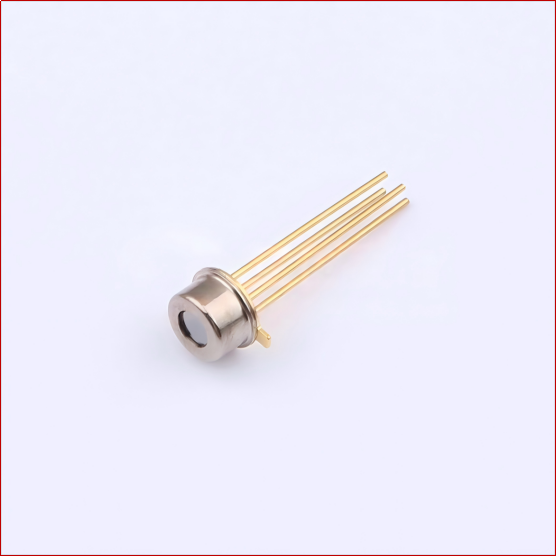Service hotline
+86 0755-83044319
release time:2024-12-11Author source:SlkorBrowse:10351
Temperature sensors play a crucial role in the functioning of modern electronics, especially in consumer electronics devices. These sensors are widely used in a variety of applications, ranging from smartphones to home appliances, to ensure proper operation by monitoring temperature changes. In this article, we will explore everything about temperature sensors, including their development, characteristics, parameters, and applications. Understanding the different aspects of a temperature sensor is essential for procurement and engineering teams in consumer electronics companies to make informed decisions.

SL-W-TRS-5.5D1 digital infrared thermopile sensor TO-46
A temperature sensor is a device designed to detect and measure temperature changes in its environment. These sensors are critical in monitoring the thermal conditions of an object or environment and can provide real-time data for efficient system control. Temperature sensors are used in various applications where precise temperature readings are required to ensure the performance and safety of electronic systems.
There are several types of temperature sensors, including thermistors, thermocouples, resistance temperature detectors (RTDs), and infrared sensors. Each of these types has distinct characteristics and is suited for different applications. Understanding the working principle behind each type can help identify the best sensor for a specific requirement.
The development of temperature sensors dates back to the early 19th century. The first significant advancement came with the invention of the thermometer. Over time, different types of temperature sensors were developed to meet the increasing demands of various industries. Early temperature sensors used mercury, while modern sensors rely on semiconductors, metals, and ceramic materials for higher precision and reliability.
As electronic devices became more complex, the need for accurate temperature control increased, leading to the development of highly specialized temperature sensors. Today, temperature sensors are an integral part of consumer electronics, automotive systems, industrial equipment, and more.
Temperature sensors come with a variety of characteristics, each suited for specific applications. Here are some key features that define the performance of a temperature sensor:
When selecting a temperature sensor for a project, it’s crucial to consider these characteristics to ensure that the sensor is suitable for the specific operating conditions.
The performance of a temperature sensor is defined by several parameters that engineers need to understand. These parameters include:
These parameters define how the temperature sensor behaves in a circuit or system, making it essential for engineers to evaluate them based on specific needs.
Temperature sensors play several roles in consumer electronics. Some of their primary functions include:
These roles demonstrate why temperature sensors are an integral part of modern electronics. Without them, it would be challenging to ensure the optimal performance and longevity of electronic systems.
Temperature sensors are used in various industries and applications. Some of the most common uses include:
In consumer electronics, temperature sensors are used in smartphones, laptops, wearables, and home appliances. These sensors monitor battery temperature to prevent overheating, enhance device longevity, and optimize energy consumption.
Temperature sensors are essential in automotive systems for engine control, cabin temperature regulation, and battery management in electric vehicles (EVs). They help maintain optimal performance and safety.
In medical devices, such as thermometers, patient monitoring systems, and wearable health devices, temperature sensors are used to track and manage body temperature, which is critical for accurate diagnosis and treatment.
Temperature sensors are also widely used in industrial settings, such as manufacturing processes, HVAC systems, and energy production. They help monitor and control temperature to improve efficiency and reduce risks.
With their versatility, temperature sensors are crucial in a wide range of applications, ensuring that products function safely and efficiently.
Several manufacturers specialize in producing high-quality temperature sensors for different applications. Some of the leading manufacturers include:
These manufacturers are key players in the temperature sensor industry and offer solutions tailored to various needs. Choosing the right manufacturer is essential for ensuring product quality and performance.
In conclusion, temperature sensors are essential components in modern electronics, with a wide range of applications across industries. Their role in ensuring safety, performance, and efficiency cannot be overstated. Whether for consumer electronics, industrial machinery, or healthcare devices, understanding the characteristics, parameters, and types of temperature sensors is crucial for engineers and procurement teams in making the right selection. By staying informed about the latest developments in temperature sensor technology and partnering with leading manufacturers, companies can ensure that their products perform reliably and efficiently.
For more detailed insights, visit Honeywell, a global leader in temperature sensor technology.









Site Map | 萨科微 | 金航标 | Slkor | Kinghelm
RU | FR | DE | IT | ES | PT | JA | KO | AR | TR | TH | MS | VI | MG | FA | ZH-TW | HR | BG | SD| GD | SN | SM | PS | LB | KY | KU | HAW | CO | AM | UZ | TG | SU | ST | ML | KK | NY | ZU | YO | TE | TA | SO| PA| NE | MN | MI | LA | LO | KM | KN
| JW | IG | HMN | HA | EO | CEB | BS | BN | UR | HT | KA | EU | AZ | HY | YI |MK | IS | BE | CY | GA | SW | SV | AF | FA | TR | TH | MT | HU | GL | ET | NL | DA | CS | FI | EL | HI | NO | PL | RO | CA | TL | IW | LV | ID | LT | SR | SQ | SL | UK
Copyright ©2015-2025 Shenzhen Slkor Micro Semicon Co., Ltd